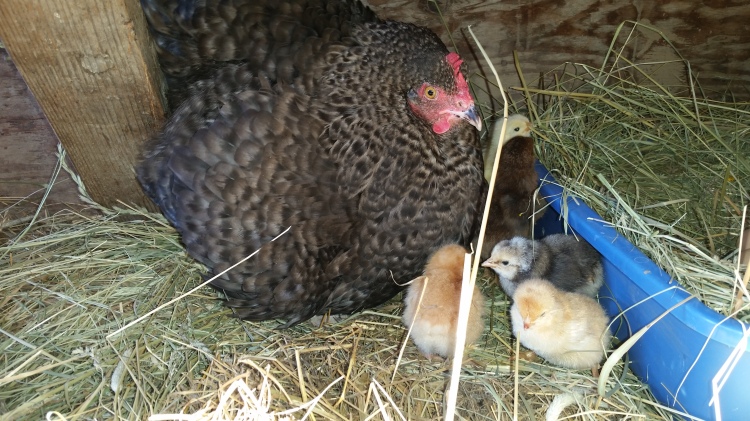Did you know that a chicken can “collect” fertilized eggs for up to a week before she begins sitting on the eggs? And that the 21-day gestation cycle doesn’t start until she begins sitting on them? Which means that there’s a one-week period where that fertilized egg could become either a chick, or an omelette?
Our broody hen was sitting on a clutch of 13 eggs that were laid over the course of 3 days, so we knew that all of the hatching should take place exactly 3 weeks later, within a 3 day window. However, of those 13 eggs, we had no idea how many were fertile. We’ve seen Milton active with the hens, but we didn’t know how thorough or equal he had been with his attentions. For all we knew, mamma hen was sitting on 13 unfertilized eggs.
However, on Day 21, I peeked under mamma and saw that one egg had pipped. Hooray! “Pipping” is when the chick first breaks through the shell with its beak. It’s the chick saying “let’s get this party started.” It takes a lot of effort to first pip through a shell, because there’s very little room for a chick to move inside of an egg. Once they pip, the rest of the hatching can take hours. The chick has to slowly “unzip” itself not only from the shell, but from the inner membrane that cocoons it.

Because nature is sometimes cruel, the very first chick to hatch didn’t have an easy time of it. Although we could see the little beak moving through the hole in the shell, the chick failed to progress beyond the initial pip. 12 hours later I checked on the nest, and two new chicks had completely hatched, but the first chick still hadn’t made it out of the shell. 12 hours after that, two more chicks had hatched, but the first chick hadn’t succeeded in making the opening any bigger than the original hole. Although hatching can take up to 24 hours, anything longer than 24 hours is a sign of a problem. I waited another 12 hours (36 total) before acknowledging that something had to be done.
Most homesteaders will tell you not to interfere with a hatching chick, for two reasons: 1. If it can’t hatch on its own, there’s a reason. That chick isn’t long for this world. 2. Your attempts to “help” a chick out of the shell are very likely to injure it. The inner membrane can dry onto a chick, and peeling it off can essentially peel off the chick’s delicate feathers and skin, causing it to bleed to death.
According to my wise homestead mentor, “Not all eggs will be fertilized, not all fertilized eggs will hatch, and not all hatched eggs will survive the first 3 days.”
Nonetheless, it was clear to me that this chick wasn’t going to make it out without assistance, so it seemed there was little to lose. I carefully peeled off the entire outer shell, and then peeled the sac off, spritzing it with warm saline solution to help rehydrate the dried membrane as I worked. Once free of that membrane, the chick appeared to be fine, if a little weak. I dipped its beak in the electrolyte water and tucked it under mama and hoped for the best.
So much of homesteading is saying Hail Mary and hoping for the best.
Sometimes it works, sometimes it doesn’t.
Just 2 days later, 6 of the 7 new chicks were feisty and robust, while the 7th chick was wobbly and not gaining weight. On day 3, it died. The 3-day survival indicator is due to the fact that chicks digest the last yolk from the shell right before they hatch, and that yolk feeds them for the first 2-3 days of life. That’s why they can be shipped in the mail without food. For some reason, some chicks don’t start eating after hatching, and once that yolk meal is gone, the chick dies. It’s farm life.
In all, we ended up with 6 new thriving “farmyard variety” chicks (e.g., mixed breeds), and our broody hen finally got what she had wanted for so long. While I was pondering how she felt about her new responsibilities–whether motherhood lived up to her expectations–I snapped this photo.

I think this captures her feelings pretty well. Here’s a closeup:


LOL! I love that last caption!
Last year we had a chick who pipped but couldn’t break free after 24 hours, so we helped it out. It turned out it was scissor-beaked, and died about two weeks later because it just couldn’t get enough to eat. We decided not to help out any more, but we’ll see how that goes. I’m a big old softy at heart 😛
LikeLike
It’s so hard to just let nature alone! I always want to “help” it succeed.
LikeLike
Uhh yeah, I know that feeling. Tell Mamma she got a buddy out here in Vegas!
LikeLiked by 1 person
I call that look, “Where’s Milton? He’s 50% responsible. Derelict Dad!”
LikeLike